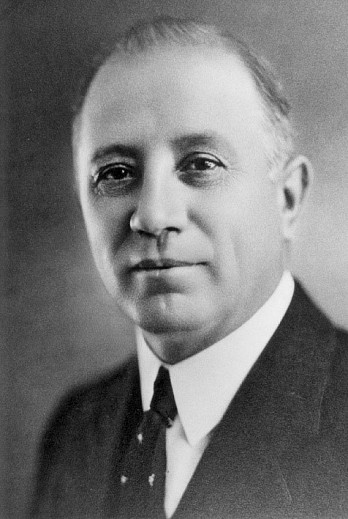
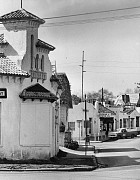
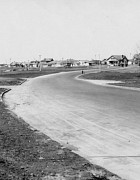
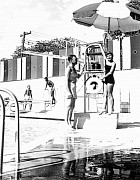
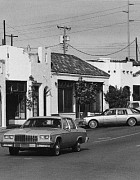
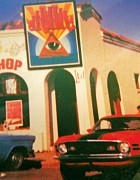
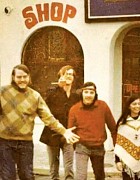
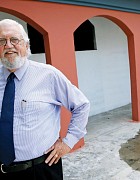
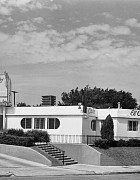
Blog: The Art of Resilience - Part I
July 16, 2020 - Joy Reed Belt
Driving through The Paseo last evening after closing the Gallery, I was reminded that communities, as well as people, must be resilient to survive. The Spanish Village, Oklahoma City's first suburban shopping district, which we now know as The Paseo, was built in the late 1920’s by one of City’s pioneering developers, G.A. Nichols, the same man who developed Nichols Hills. To support his two-block curved street commercial district on what he dubbed Paseo Drive, Nichols also built twelve of Oklahoma City’s “best apartment buildings." This residential development was carved out of an area platted as Guernsey Park Place because it once had been dotted with small dairy farms. Since Nichols’ architectural muse was his cousin, who built The Plaza Shopping Center in Kansas City, the buildings in Paseo are primarily a miniaturized version of Spanish Revival Architecture. Dr. Fred and Nan Sheets had already built their resident Art Studio and Gallery, The Elms, on nearby Walker Avenue in the Spanish Mission architectural style, so the area enjoyed and continues to enjoy a somewhat interesting and artsy ambiance.
By the time that the Spanish Village Shopping Center was completed the whole country was in the throes of the Great Depression. Paseo stumbled but it survived. Some of the shops that had been designed to offer finery and luxury objects were repurposed to offer more functional goods and services. One of the charming little buildings, which is now Picasso’s Cafe, became Marshall Funeral Home, another building El Criterion Cleaners and yet another, Quality Cleaners. Next to the funeral home there was Wahl Shoe Repair. Stotts Filling Station was built on a corner lot and a grocery, Fresher Food Store was down the street as was Spurlock Brothers Grocery. A few years later, Oklahoma City’s first municipal swimming pool, The Plunge, was built on Paseo Drive.
For almost 50 years, families with children would go to the Paseo to swim, or get their hair cut, their shoes soled, or to grab a soda at Veazey Drug Store. In the 50’s, The Paseo provided “The Blue Note” as well as “Bill Phillips," and "The Yellow Submarine.” As my late husband, John Belt always said, Paseo had “enough beer, wine and liquor to lubricate the senses.” In the late 60’s hundreds of young people would gather in the Paseo to listen to the same music and participate in the same activities as their counterparts across the country, part of the “Hippie” generation.
But in the mid-70s things changed. The Paseo Plunge had closed due to the polio epidemic. People were moving to the suburbs. Massive indoor shopping centers were being built throughout the metropolitan area. Some of the charming little buildings on Paseo Drive were either closed or converted into storage facilities. The street had lost some of its luster and became uncharacteristically quiet. However, there were still a few signs of life. A young chef from California put in a sandwich shop called Hirams in the former funeral home and lived in the back of the shop. The Macramé Café opened in a wonderful building that had been Valeteria Cleaning Service, offering delicious breads and pastries. El Charrito's Mexican Restaurant, which occupied the building where Paseo Grill is currently located, was a very popular restaurant that managed almost single handedly to bring people to the area. Importantly, something of a trend began to appear, as artists tentatively began exploring the area in search of reduced rents with the hope of creating live/workspaces.
In 1976, the young man who owned the deli restaurant, Hirams, only had month- to- month tenancy, and a businessman down the street had arranged to obtain the building from the owner for the purpose of turning it in to warehousing for a restaurant supply business. The young man was distraught and asked John Belt for his help. John got in his car and drove to Paseo and slowly looked at the buildings. It brought back many memories. John determined that he needed to help his client, to help “The Street” and to help the larger community. He then drove to the courthouse and examined the title to both sides of The Paseo from 30th Street down its curved corridor to its intersection with Walker at 28th street. He returned to his office, called his banker and arranged for funds. He then contacted the owner of the group of buildings that housed “Hiram’s” and made him an offer to purchase. That offer was accepted and the sale closed the next day. John then called the owner of property across the street who also agreed to sell. The next day John paid a visit to the restaurant supply owner and told him he had bought the adjacent buildings and was willing to buy his. He made an offer on the man’s building and told the owner the offer would remain open for one year. After six months the owner called and accepted the offer. John Belt then set out on what became his lifelong project to revitalize the Paseo neighborhood.
Images:
Gilbert Apple "G.A." Nichols (1876-1950)
Paseo, c. 1920s
Paseo, c. 1970s
Paseo, c. 1970s
Paseo Plunge, c. 1950s
Mother's Rock Shop, 1970s
Mother's Rock Shop, 1970s
El Charrito, c.1960s, was located in the building that currently houses Paseo Grill, 2909 Paseo St
John Belt (1936-2013)
Download Article (PDF)Back to Blogs
